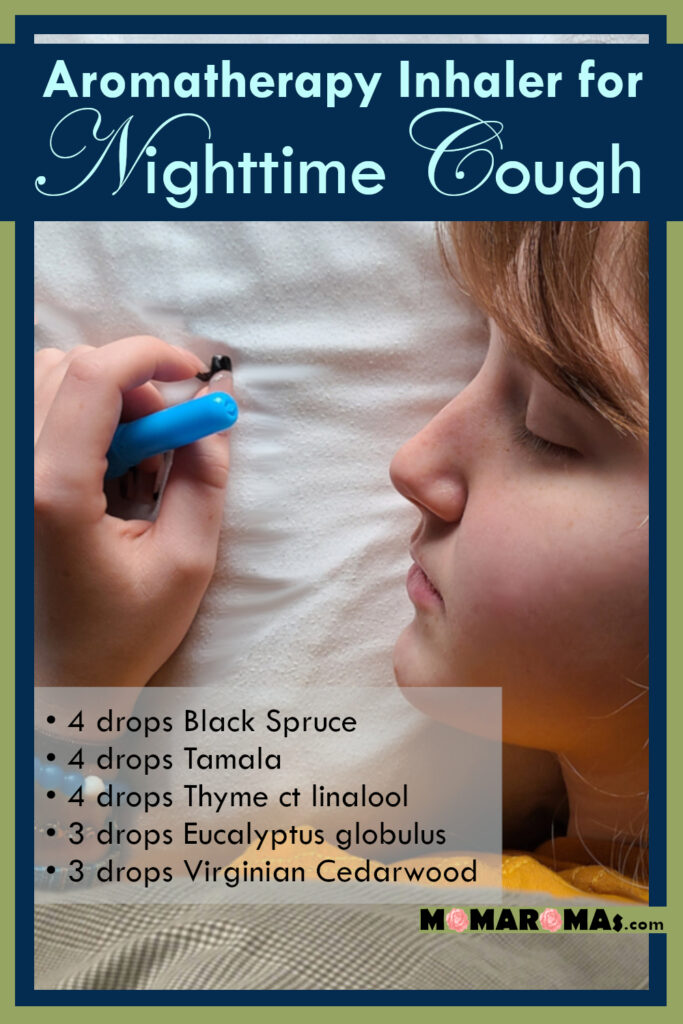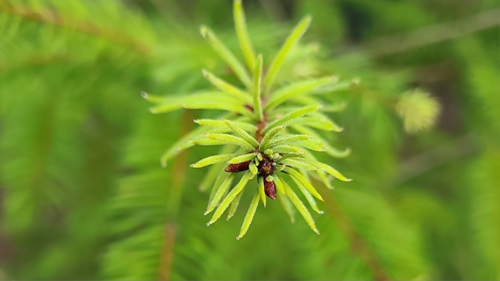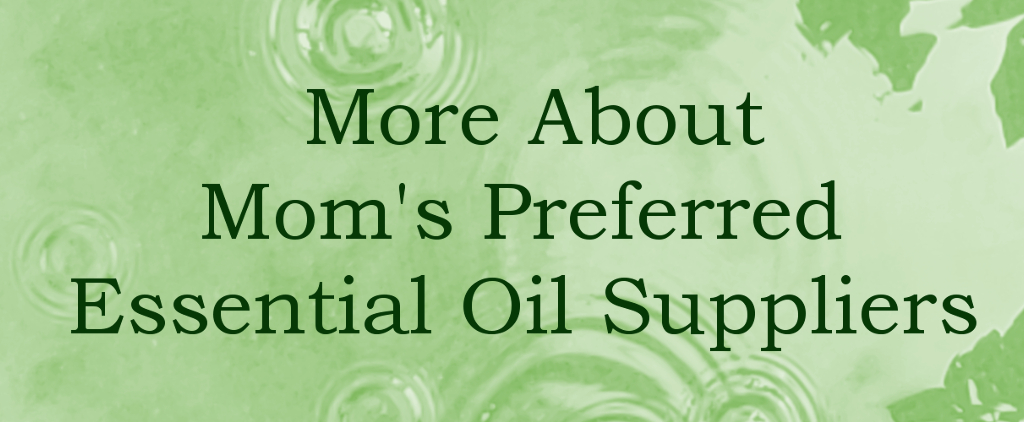Nighttime Cough (Part 1) – The Inhaler Blend
Nothing is quite as miserable as cough spasms that wake you from sleep or that keep you from sleeping. Cold symptoms during the day are rough. For me, though, a nighttime cough is worse.
Sleep is an important aspect of wellness when you don’t have a cold. It’s even more important when you do!
So, after struggling to get restful sleep due to a nighttime cough that was merely dulled by a menthol vapor chest rub, I went into Mom’s Lab and began formulating.
Wanting to have focused concentrated support, I decided on an aromatherapy inhaler. (See my tricky tip for using an inhaler through the night in Part 2!)

[This post contains affiliate links. If you make a purchase through one of these links I may earn a commission. This does not impact your price. For more information, please see our disclosure.]
In this Post:
About the Inhaler Blend
Creating a blend that supports restful sleep while also providing respiratory support can be difficult. That’s because many of the breath-opening essential oils can also be energizing. The last thing you need is for your brain to be ready to go when your body really just needs to rest.
The goal was to select essential oils that would maximize the calming, breath-opening, and decongesting properties of the final blend.
After several nights of using the Nighttime Cough Inhaler and finally getting some much needed restful sleep, I thought I’d share my aromatherapy blend and why I chose these essential oils.
⭐️Nighttime Cough Inhaler Recipe
- Aromatherapy inhaler and wick*
- Small bowl or glass
- Pair of tweezers
- 4 drops Black Spruce essential oil (Picea mariana)
- 4 drops Tamala essential oil (Cinnamomum tamala ct linalool)
- 4 drops Thyme ct linalool essential oil (Thymus vulgaris ct linalool)
- 3 drops Eucalyptus globulus essential oil
- 3 drops Virginian Cedarwood essential oil (Juniperus virginiana)
*I recommend a disposable inhaler, so it can be disposed of once you are feeling better.
🌺See my Recommended Suppliers below
Make your Nighttime Cough Inhaler

- Combine the essential oils in the small bowl or glass.
- Add inhaler wick and allow it to absorb the essential oils.
- Use the tweezers to transfer the saturated wick to the inhaler tube.
- Snap cover in place.
To use, inhale slowly through each nostril several times before bed and as needed through the night.
(Or see my little trick in Part 2 of this post.)
Chemistry: Essential Oils for Respiratory Support
Camphene
If you’ve ever sniffed Black Spruce essential oil, you likely noted that the aroma encourages really deep breaths (if you haven’t, next time you open a bottle, sniff the cap). Black Spruce contains camphene which encourages that deep breathing, and it also helps thin bronchial secretions to make a nighttime cough more productive.[1]
1,8-Cineole
You might recognize 1,8-cineole, as this is the phytochemical contributing to that unmistakable aroma of Eucalyptus. In fact, another name for 1,8-cineole is “eucalyptol.” Not only does 1,8-cineole help open the airway, it helps thin secretions and reduces inflammation of the bronchial tissues.[2] In this blend, Eucalyptus and Tamala contribute 1,8-cineole.

🔶1,8-Cineole Safety Considerations
Care should be taken with those who have asthma. Some may be sensitive to essential oils with 1,8-cineole. Before using, test for airway constriction by smelling the caps of the Tamala and Eucalyptus essential oils.
Not for use by or close to very small children as eucalyptol can be irritating to their sensitive airways.

Chemistry: Essential Oils for Sleep Support
So, now that we have the respiratory support covered, let’s take a closer look at the essential oil components that help calm our minds and bodies so we can sleep.
Bornyl Acetate
Back to Black Spruce. Not only is it soothing to the respiratory system, it also has a lovely calming effect. I consider it the bridge that brings together the breath-opening and sleep-supporting properties of this nighttime cough blend. Black Spruce contains significant bornyl acetate, which helps relax the autonomic nervous system, promoting a more restful state.[3]
Pinenes
Next time you are walking in a wooded area, particularly one with evergreens, notice the fragrance of the air. Take note of the impact it has on your psyche. Those are pinenes you are inhaling! These volatile terpenes are what make a Forest Walk so calming and emotionally soothing.
Pinenes, and specifically α-pinene, can profoundly reduce feelings of anxiety.[4] This, in turn, enhances feelings of well-being and reduces tension, contributing to a more restful sleep. Black Spruce, Tamala, and Thyme contribute α-pinene to this blend.
Linalool
You might recognize the phytochemical linalool. It’s one of the main components responsible for the calming effect of Lavender. Linalool has a long history of scientifically supported use as a gentle sedative and Lavender has hundreds of years of anecdotal evidence as a sleep aid.[5] In this blend Tamala and Thyme contribute significant amounts of linalool.
Cedrol
And finally cedrol is a beautifully grounding phytochemical. It’s one of the components that make Virginian Cedarwood calming and sleep-supporting. It helps reduce sympathetic (fight-flight-freeze) activity and promotes the parasympathetic (rest-relax) response.[6]
So, inhale slowly and rest deeply!

References
- Aswandi, A., Kholibrina, C.R. (2021). Ethnomedicine of forest’s essential oils for respiratory and cardiovascular treatments in Northern Sumatra. IOP Conf Ser: Earth Environ Sci, 914. https://doi.org/10.1088/1755-1315/914/1/012073
- Juergens, L.J., Worth, H., Juergens, U.R. (2020). New perspectives for mucolytic, anti-inflammatory and adjunctive therapy with 1,8-cineole in COPD and asthma: review on the new therapeutic approach. Adv Ther, 37(5):1737-53. https://doi.org/10.1007/s12325-020-01279-0
- Matsabara, E., Fukagawa, M., Okamoto, T., Ohnuki, K., Shimizu, K., Kondo, R. (2011). (-)-Bornyl acetate induces autonomic relaxation and reduces arousal level after visual display terminal work without any influences of task performance in low-dose condition. Biomed Res, 32(2):151-7. https://doi.org/10.2220/biomedres.32.151
- Kasuya, H., Iida, S., Ono, K., Satou, T., Koike, K. (2015). Intracerebral distribution of α-Pinene and the anxiolytic-like effect in mice following inhaled administration of essential oil from Chamaecyparis obtusa. Nat Prod Commun, 10(8):1479-82. https://doi.org/10.1177/1934578X1501000841
- Buchbauer, G., Jirovetz, L., Jäger, W. (1991). Aromatherapy: evidence for sedative effects of the essential oil of lavender after inhalation. Zeitschrift für Naturforschung C, 46(11-12):1067-72. https://doi.org/10.1515/znc-1991-11-1223
- Dayawansa, S., Umeno, K., Takakura, H., Hori, E., Tabuchi, E., Nagashima, Y., Oosu, H., Yada, Y., Suzuki, T., Ono, T., Nishijo, H. (2003). Autonomic responses during inhalation of natural fragrance of cedrol in humans. Auton Neurosci, 31;108(1-2):79-86. https://doi.org/10.1016/j.autneu.2003.08.002


📌Cough & Cold Pins

Mom’s Nighttime Cough Shopping List
You can find the ingredients (except Tamala essential oil) and disposable inhalers to make Nighttime Cough Inhaler in my Amazon Cough & Cold Care shopping list or visit one of my favorite suppliers.
- Aromatherapy Inhalers:
- Black Spruce essential oil (Picea mariana):
- Aromatics International, organic💛
- Plant Therapy, organic (Direct and Amazon).
- Eucalyptus globulus essential oil:
- Aromatics International, organic
- Plant Therapy, organic (Direct and Amazon).
- Tamala essential oil (Cinnamomum tamala ct linalool):
- Aromatics International, wildcrafted.
- Thyme essential oil (Thymus vulgaris) – both chemotypes:
- Aromatics International, ct linalool (gentle), organic
- Plant Therapy, ct linalool (gentle), sustainable (Direct and Amazon)
- Aromatics International, ct thymol (powerful), organic
- Plant Therapy, ct thymol (powerful), organic (Direct and Amazon).
- Cedarwood Virginian essential oil (Juniperus virginiana):
- Aromatics International, wildcrafted
- Plant Therapy, sustainable (Direct and Amazon).
This information has not been evaluated by the Food and Drug Administration and is not intended to diagnose, treat, cure, or prevent any disease. It is for educational purposes only.
All recipes provided are for personal use and are not designed for re-sale or large-scale manufacturing.
Please consult your doctor, naturopath, herbal practitioner, or other qualified health professional for medical advice and before starting any herbal regimen, particularly if you are pregnant or nursing, have any existing medical conditions, or are taking any medications.

Chris P | Author, Certified Aromatherapist, Natural Skin Care Formulator
Chris (“Mom”) enjoys formulating bespoke aromatherapy, skin care, and herbal products to support her family, pets, friends, and clients. She also loves experimenting with recipes in the kitchen. An avid reader, writer, and lifetime learner, Chris enthusiastically explores research rabbit holes and then writes about her discoveries.💚 (Learn more >>)






